The NVIDIA GeForce GTX 1080 & GTX 1070 Founders Editions Review: Kicking Off the FinFET Generation
by Ryan Smith on July 20, 2016 8:45 AM ESTFast Sync & SLI Updates: Less Latency, Fewer GPUs
Since Kepler and the GTX 680 in 2012, one of NVIDIA’s side projects in GPU development has been cooking up ways to reduce input lag. Under the watchful eye of NVIDIA’s Distinguished Engineer (and all-around frontman) Tom Petersen, the company has introduced a couple of different technologies over the years to deal with the problem. Kepler introduced adaptive v-sync – the ability to dynamically disable v-sync when the frame rate is below the refresh rate – and of course in 2013 the company introduced their G-Sync variable refresh rate technology.
Since then, Tom’s team has been working on yet another way to bend the rules of v-sync. Rolling out with Pascal is a new v-sync mode that NVIDIA is calling Fast Sync, and it is designed to offer yet another way to reduce input lag while maintaining v-sync.
It’s interesting to note that Fast Sync isn’t a wholly new idea, but rather a modern and more consistent take on an old idea: triple buffering. While in modern times triple buffering is just a 3-deep buffer that is run through as a sequential frame queue, in the days of yore some games and video cards handled triple buffering a bit differently. Rather than using the 3 buffers as a sequential queue, they would instead always overwrite the oldest buffer. This small change had a potentially significant impact on input lag, and if you’re familiar with old school triple buffering, then you know where this is going.
With Fast Sync, NVIDIA has implemented old school triple buffering at the driver level, once again making it usable with modern cards. The purpose of implementing Fast Sync is to reduce input lag in modern games that can generate a frame rate higher than the refresh rate, with NVIDIA specifically targeting CS:GO and other graphically simple twitch games.
But how does Fast Sync actually reduce input lag? To go into this a bit further, we have an excellent article on old school triple buffering from 2009 that I’ve republished below. Even 7 years later, other than the name the technical details are all still accurate to NVIDIA’s Fast Sync implementation.
What are Double Buffering, V-sync, and Triple Buffering?
When a computer needs to display something on a monitor, it draws a picture of what the screen is supposed to look like and sends this picture (which we will call a buffer) out to the monitor. In the old days there was only one buffer and it was continually being both drawn to and sent to the monitor. There are some advantages to this approach, but there are also very large drawbacks. Most notably, when objects on the display were updated, they would often flicker.
In order to combat the issues with reading from while drawing to the same buffer, double buffering, at a minimum, is employed. The idea behind double buffering is that the computer only draws to one buffer (called the "back" buffer) and sends the other buffer (called the "front" buffer) to the screen. After the computer finishes drawing the back buffer, the program doing the drawing does something called a buffer "swap." This swap doesn't move anything: swap only changes the names of the two buffers: the front buffer becomes the back buffer and the back buffer becomes the front buffer.
After a buffer swap, the software can start drawing to the new back buffer and the computer sends the new front buffer to the monitor until the next buffer swap happens. And all is well. Well, almost all anyway.
In this form of double buffering, a swap can happen anytime. That means that while the computer is sending data to the monitor, the swap can occur. When this happens, the rest of the screen is drawn according to what the new front buffer contains. If the new front buffer is different enough from the old front buffer, a visual artifact known as "tearing" can be seen. This type of problem can be seen often in high framerate FPS games when whipping around a corner as fast as possible. Because of the quick motion, every frame is very different, when a swap happens during drawing the discrepancy is large and can be distracting.
The most common approach to combat tearing is to wait to swap buffers until the monitor is ready for another image. The monitor is ready after it has fully drawn what was sent to it and the next vertical refresh cycle is about to start. Synchronizing buffer swaps with the Vertical refresh is called V-sync.
While enabling V-sync does fix tearing, it also sets the internal framerate of the game to, at most, the refresh rate of the monitor (typically 60Hz for most LCD panels). This can hurt performance even if the game doesn't run at 60 frames per second as there will still be artificial delays added to effect synchronization. Performance can be cut nearly in half cases where every frame takes just a little longer than 16.67 ms (1/60th of a second). In such a case, frame rate would drop to 30 FPS despite the fact that the game should run at just under 60 FPS. The elimination of tearing and consistency of framerate, however, do contribute to an added smoothness that double buffering without V-sync just can't deliver.
Input lag also becomes more of an issue with V-sync enabled. This is because the artificial delay introduced increases the difference between when something actually happened (when the frame was drawn) and when it gets displayed on screen. Input lag always exists (it is impossible to instantaneously draw what is currently happening to the screen), but the trick is to minimize it.
Our options with double buffering are a choice between possible visual problems like tearing without V-sync and an artificial delay that can negatively affect both performance and can increase input lag with V-sync enabled. But not to worry, there is an option that combines the best of both worlds with no sacrifice in quality or actual performance. That option is triple buffering.
The name gives a lot away: triple buffering uses three buffers instead of two. This additional buffer gives the computer enough space to keep a buffer locked while it is being sent to the monitor (to avoid tearing) while also not preventing the software from drawing as fast as it possibly can (even with one locked buffer there are still two that the software can bounce back and forth between). The software draws back and forth between the two back buffers and (at best) once every refresh the front buffer is swapped for the back buffer containing the most recently completed fully rendered frame. This does take up some extra space in memory on the graphics card (about 15 to 25MB), but with modern graphics card dropping at least 512MB on board this extra space is no longer a real issue.
In other words, with triple buffering we get almost the exact same high actual performance and similar decreased input lag of a V-sync disabled setup while achieving the visual quality and smoothness of leaving V-sync enabled.
Note however that the software is still drawing the entire time behind the scenes on the two back buffers when triple buffering. This means that when the front buffer swap happens, unlike with double buffering and V-sync, we don't have artificial delay. And unlike with double buffering without V-sync, once we start sending a fully rendered frame to the monitor, we don't switch to another frame in the middle.
The end result of Fast Sync is that in the right cases we can have our cake and eat it too when it comes to v-sync and input lag. By constantly rendering frames as if v-sync was off, and then just grabbing the most recent frame and discarding the rest, Fast Sync means that v-sync can still be used to prevent tearing without the traditionally high input lag penalty it causes.
The actual input lag benefits will in turn depend on several factors, including frame rates and display refresh rates. The minimum input lag is still the amount of time it takes to draw a frame – just like with v-sync off – and then you have to wait for the next refresh interval to actually display the frame. Thanks to the law of averages, the higher the frame rate (the lower the frame rendering time), the better the odds that a frame is ready right before a screen refresh, reducing the average amount of input lag. This is especially true on 60Hz displays where there’s a full 16.7ms between frame draws and a traditional double buffered setup (or sequential frame queue).
NVIDIA’s own example numbers are taken from monitoring CS:GO with a high speed camera. I can’t confirm these numbers – and as with most marketing efforts it’s like a best-case scenario – but their chart isn’t unreasonable, especially if their v-sync example uses a 3-deep buffer. Input lag will be higher than without v-sync, but lower (potentially much so) than with v-sync on. Overall the greatest benefits are with a very high framerate, which is why NVIDIA is specifically targeting games like CS:GO, as a frame rate multiple times higher than the refresh rate will produce the best results.
With all of the above said, I should note that Fast Sync is purely about input lag and doesn’t address smoothness. In fact it may make things a little less smooth because it’s essentially dropping frames, and the amount of simulation time between frames can vary. But at high framerates this shouldn’t be an issue. Meanwhile Fast Sync means losing all of the power saving benefits of v-sync; rather than the GPU getting a chance to rest and clock down between frames, it’s now rendering at full speed the entire time as if v-sync was off.
Finally, it’s probably useful to clarify how Fast Sync fits in with NVIDIA’s other input lag reduction technologies. Fast Sync doesn’t replace either Adaptive V-Sync or G-Sync, but rather compliments them.
- Adaptive V-Sync: reducing input lag when framerates are below the refresh rate by selectively disabling v-sync
- G-Sync: reducing input lag by refreshing the screen when a frame is ready, up to the display’s maximum refresh rate
- Fast Sync: reducing input lag by not stalling the GPU when the framerate hits the display’s refresh rate
Fast Sync specifically deals with the case where frame rates exceed the display’s refresh rate. If the frame rate is below the refresh rate, then Fast Sync does nothing since it takes more than a refresh interval to render a single frame to begin with. And this is instead where Adaptive Sync would come in, if desired.
Meanwhile when coupled with G-Sync, Fast Sync again only matters when the frame rate exceeds the display’s maximum refresh rate. For most G-Sync monitors this is 120-144Hz. Previously the options with G-Sync above the max refresh rate were to tear (no v-sync) or to stall the GPU (v-sync), so this provides a tear-free lower input lag option for G-Sync as well.



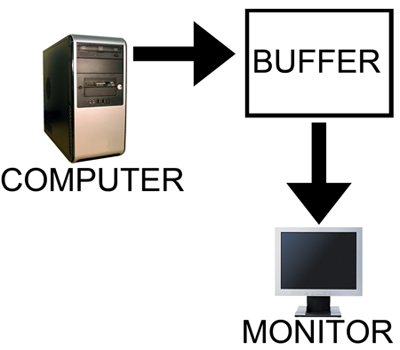
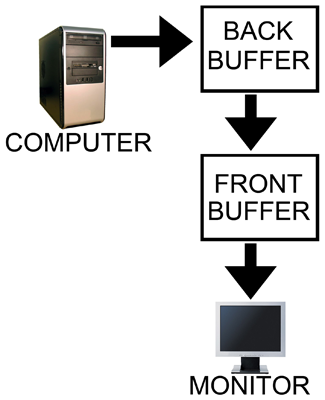
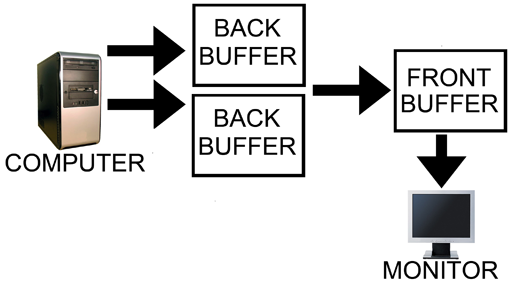
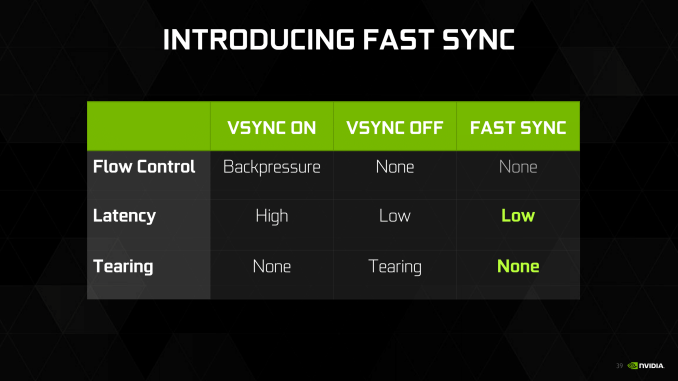
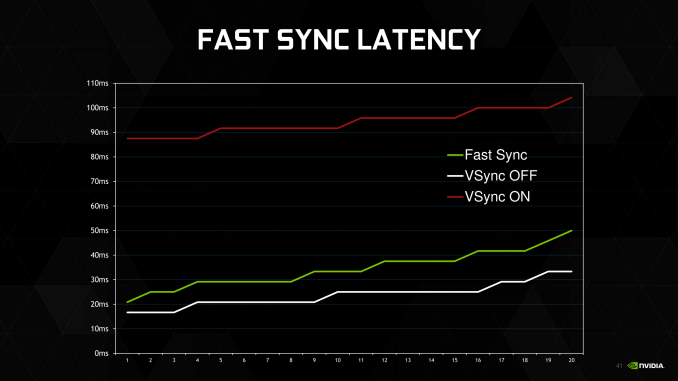








200 Comments
View All Comments
eddman - Wednesday, July 20, 2016 - link
That puts a lid on the comments that Pascal is basically a Maxwell die-shrink. It's obviously based on Maxwell but the addition of dynamic load balancing and preemption clearly elevates it to a higher level.Still, seeing that using async with Pascal doesn't seem to be as effective as GCN, the question is how much of a role will it play in DX12 games in the next 2 years. Obviously async isn't be-all and end-all when it comes to performance but can Pascal keep up as a whole going forward or not.
I suppose we won't know until more DX12 are out that are also optimized properly for Pascal.
javishd - Wednesday, July 20, 2016 - link
Overwatch is extremely popular right now, it deserves to be a staple in gaming benchmarks.jardows2 - Wednesday, July 20, 2016 - link
Except that it really is designed as an e-sport style game, and can run very well with low-end hardware, so isn't really needed for reviewing flagship cards. In other words, if your primary desire is to find a card that will run Overwatch well, you won't be looking at spending $200-$700 for the new video cards coming out.Ryan Smith - Wednesday, July 20, 2016 - link
And this is why I really wish Overwatch was more demanding on GPUs. I'd love to use it and DOTA 2, but 100fps at 4K doesn't tell us much of use about the architecture of these high-end cards.Scali - Wednesday, July 20, 2016 - link
Thanks for the excellent write-up, Ryan!Especially the parts on asynchronous compute and pre-emption were very thorough.
A lot of nonsense was being spread about nVidia's alleged inability to do async compute in DX12, especially after Time Spy was released, and actually showed gains from using multiple queues.
Your article answers all the criticism, and proves the nay-sayers wrong.
Some of them went so far in their claims that they said nVidia could not even do graphics and compute at the same time. Even Maxwell v2 could do that.
I would say you have written the definitive article on this matter.
The_Assimilator - Wednesday, July 20, 2016 - link
Sadly that won't stop the clueless AMD fanboys from continuing to harp on that NVIDIA "doesn't have async compute" or that it "doesn't work". You've gotta feel for them though, NVIDIA's poor performance in a single tech demo... written with assistance from AMD... is really all the red camp has to go on. Because they sure as hell can't compete in terms of performance, or power usage, or cooler design, or adhering to electrical specifications...tipoo - Wednesday, July 20, 2016 - link
Pretty sure critique was of Maxwell. Pascals async was widely advertised. It's them saying "don't worry, Maxwell can do it" to questions about it not having it, and then when Pascal is released, saying "oh yeah, performance would have tanked with it on Maxwell", that bugs people as it shouldScali - Wednesday, July 20, 2016 - link
Nope, a lot of critique on Time Spy was specifically *because* Pascal got gains from the async render path. People said nVidia couldn't do it, so FutureMark must be cheating/bribed.darkchazz - Thursday, July 21, 2016 - link
It won't matter much though because they won't read anything in this article or Futuremark's statement on Async use in Time Spy.And they will keep linking some forum posts that claim nvidia does not support Async Compute.
Nothing will change their minds that it is a rigged benchmark and the developers got bribed by nvidia.
Scali - Friday, July 22, 2016 - link
Yea, not even this official AMD post will: http://radeon.com/radeon-wins-3dmark-dx12/